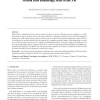Free Online Productivity Tools
i2Speak
i2Symbol
i2OCR
iTex2Img
iWeb2Print
iWeb2Shot
i2Type
iPdf2Split
iPdf2Merge
i2Bopomofo
i2Arabic
i2Style
i2Image
i2PDF
iLatex2Rtf
Sci2ools
CGF
2011
2011
Motion Blur Rendering: State of the Art
Motion blur is a fundamental cue in the perception of objects in motion. This phenomenon manifests as a visible trail along the trajectory of the object and is the result of the combination of relative motion and light integration taking place in film and electronic cameras. In this work, we analyse the mechanisms that produce motion blur in recording devices and the methods that can simulate it in computer generated images. Light integration over time is one of the most expensive processes to simulate in high-quality renders, as such, we make an in-depth review of the existing algorithms and we categorize them in the context of a formal model that highlights their differences, strengths and limitations. We finalize this report proposing a number of alternative classifications that will help the reader identify the best technique for a particular scenario.
| Added | 13 May 2011 |
| Updated | 13 May 2011 |
| Type | Journal |
| Year | 2011 |
| Where | CGF |
| Authors | Fernando Navarro, Francisco J. Serón, Diego Gutierrez |
Comments (0)

